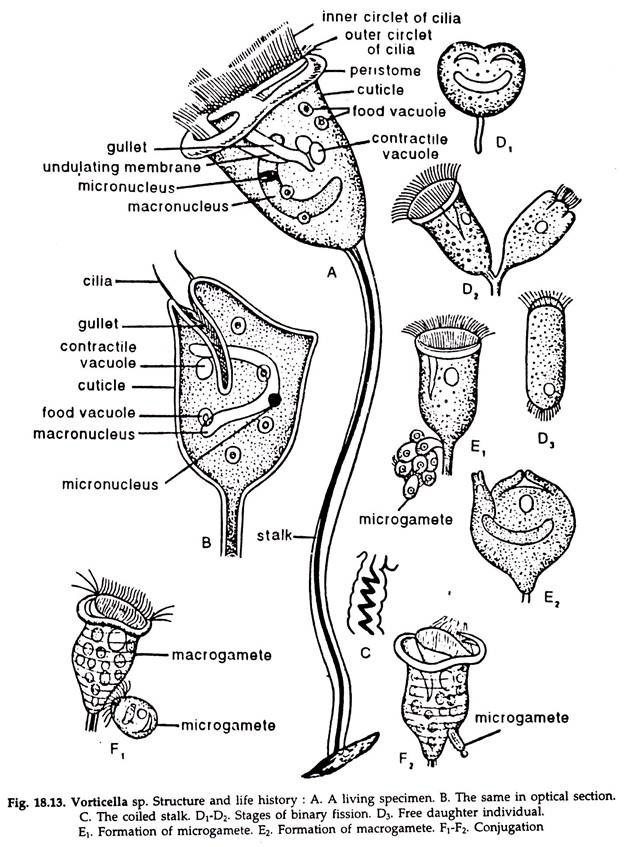In this article we will discuss about the structure and reproduction of vorticella, explained with the help of a suitable diagram.
Structure of Vorticella:
1. The body is a solid inverted bell from the base of which runs a narrow stalk made of contractile elements by which the animal is permanently attached to some submerged substratum (Fig. 18.13).
2. The margin of the bell is thickened to a rim-like structure, the peristome.
ADVERTISEMENTS:
3. A disc-like structure is present on the peristome at the top of the bell.
4. The mouth lies between the peristome and the disc and the tube connecting the gullet and the mouth is known as vestibule. In the vestibule opens the reservoir and it contains the anal spot.
5. The cilia are large and arranged in rings around the peristome and the disc. The cilia fuse to form an undulating membrane in the vestibule.
6. Reservoir, food vacuoles and a contractile vacuole are present.
ADVERTISEMENTS:
7. Nuclei are two in number; the micro- nucleus is small and rounded and the macro- nucleus is large and horse shoe-shaped.
Reproduction in Vorticella:
Vorticella reproduces both by asexual and sexual means. Asexual reproduction is effected by fission and this is the normal mode of reproduction in Vorticella.
Asexual Reproduction:
1. It takes place by longitudinal binary fission.
ADVERTISEMENTS:
2. Both the micro- and macronuclei become elongated and a constriction appears in the middle of each nucleus.
3. A constriction appears at the middle of the disc and a mouth, vestibule and gullet appear on that half which lacks these structures.
4. The constriction of the cytoplasm runs inward, each nucleus divides into two; the micronucleus by mitosis and the macronucleus by vegetative division; one new contractile vacuole, reservoir and anal spot appear and two identical daughter Vorticella are produced on the original stalk.
5. One of the two daughter individuals gets detached from the stalk, develops a second circlet of cilia at the basal end, assumes the shape of a barrel and becomes free swimming.
6. After a brief period of free life the second circlet of cilia is lost, and developing a stalk from that end, the animal becomes permanently attached to some substratum.
Vorticella is a sedentary animal. By developing a free living stage at the time of reproduction, the non-locomotory species becomes locomotory and, by its dispersal, overcrowding of individuals in a limited area is avoided.
Sexual Reproduction:
It takes place by conjugation. After a number of generations produced by binary fission the individuals appear weakened and unhealthy and conjugation takes place at this stage. The conjugation is permanent in Vorticella and it resembles fertilization to some extent. The different types of gametes produced during conjugation are known as macrogamete and microgamete.
Formation of macrogamete:
ADVERTISEMENTS:
1. The micronucleus of some of the weakened, ordinary stalked individuals, undergoes one meiotic division and two daughter nuclei with half the original number of chromosomes are produced in each individual.
2. One of the two nuclei disappears and the individual is now known as macrogamete.
Formation of microgamete:
1. Vegetative structures of some of the weakened individuals disappear and the micronucleus divides thrice, of which one is meiotic and 8 daughter nuclei with half the original number of chromosomes are formed.
2. The cytoplasm fragments, a small bit surrounds each daughter nucleus and 8 microgametes are produced.
3. The microgamete is oval with one end pointed. At the pointed end, a circlet of cilia develops and the gametes come out leaving the mother animal empty.
Conjugation:
The microgametes swim in water and one comes to rest on a macrogamete at the junction of the bell and the stalk. A protoplasmic bridge is established between the two and the nucleus of the microgamete migrates to fuse with the nucleus of the microgamete. The cytoplasm of the microgamete is lost and the macrogamete now with the fusion nucleus acts as a healthy ordinary Vorticella.
Effect of conjugation:
The essence of conjugation is the reception of nuclear material from another individual: its effect appears to be a renewal of vitality which is essential for rapid reproduction by binary fission.
